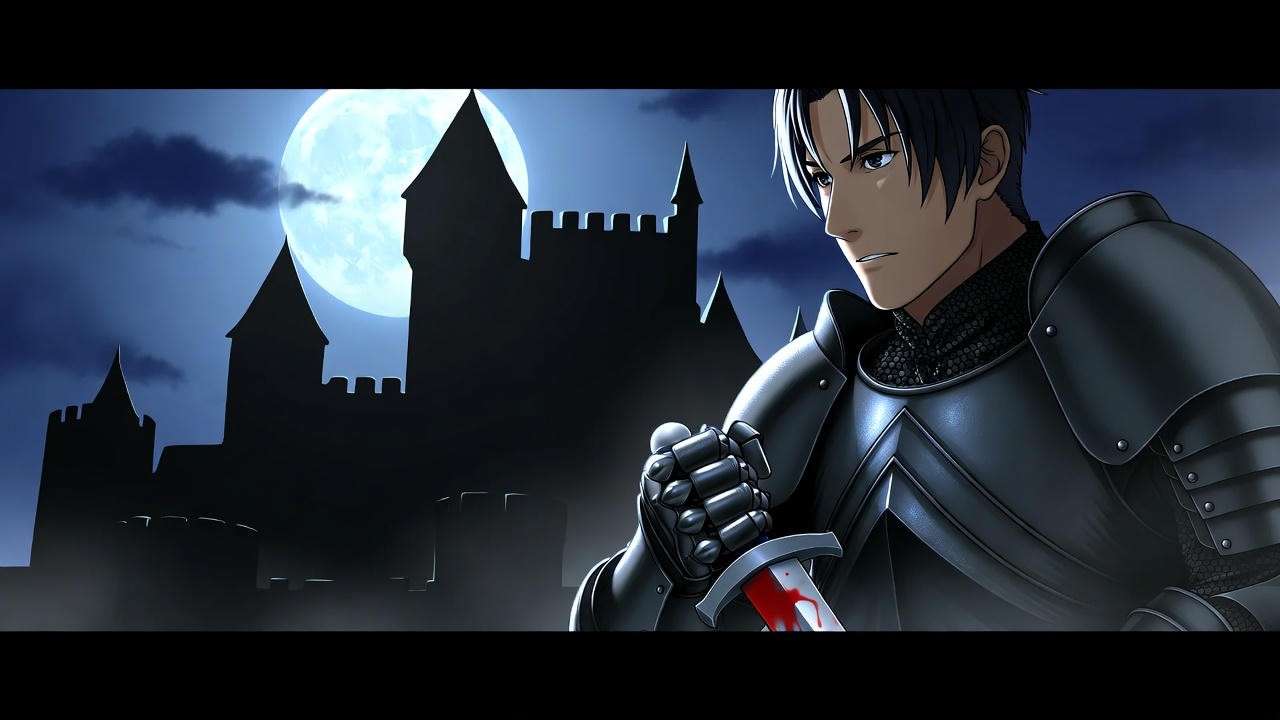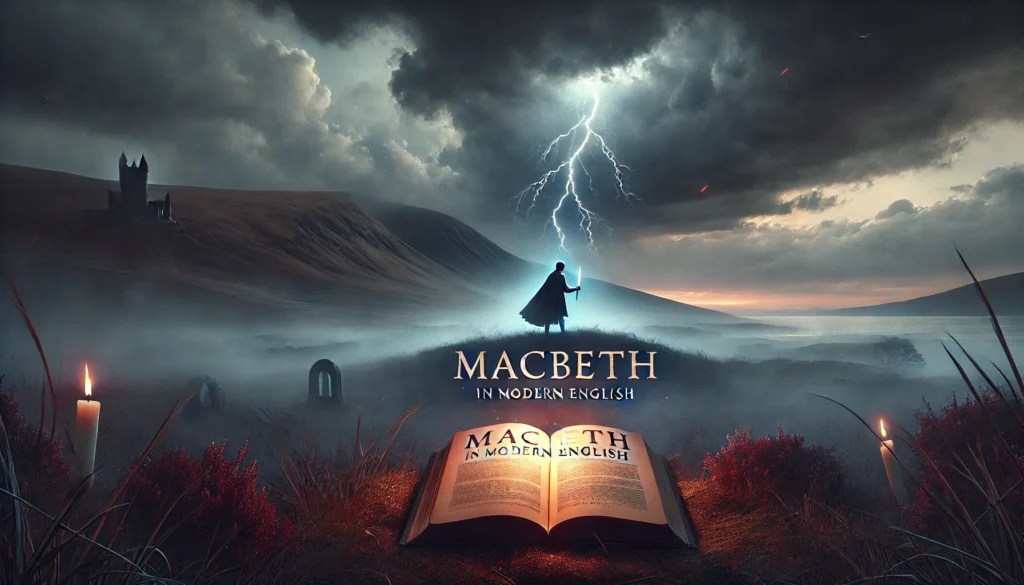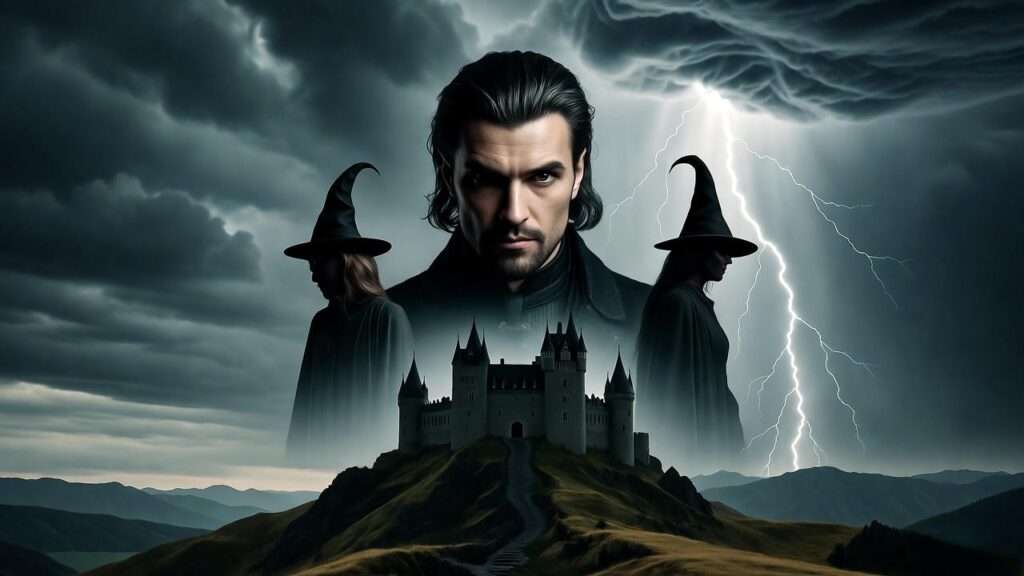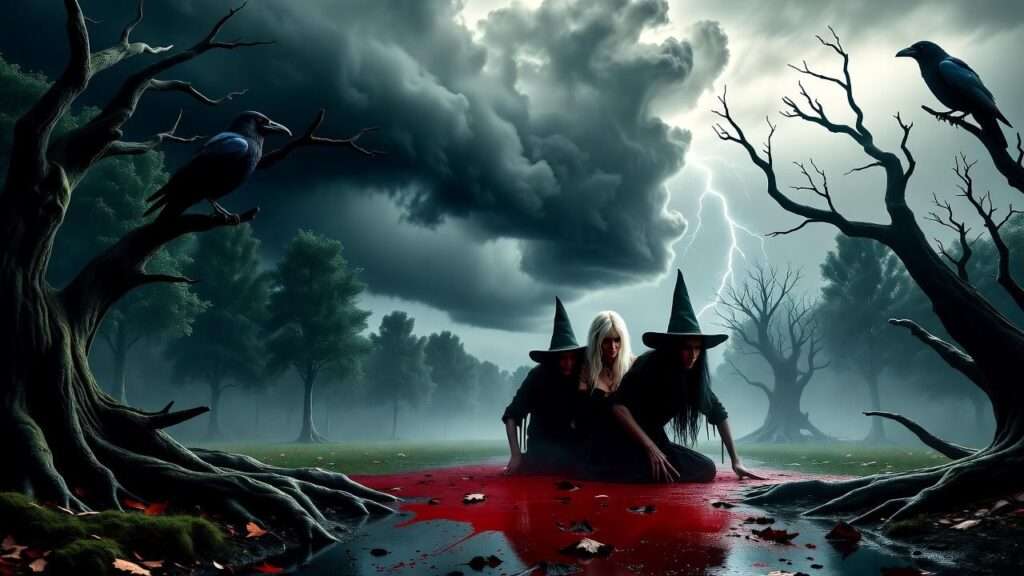Picture three witches huddled on a stormy heath, their cryptic words igniting a spark of ambition that will consume a noble warrior and plunge a kingdom into chaos. Macbeth, William Shakespeare’s darkest tragedy, weaves a gripping tale of power, guilt, and fate that continues to captivate readers and audiences. For students grappling with the play’s dense language or enthusiasts seeking a deeper understanding, this Macbeth act-wise summary offers a clear, concise breakdown of each act, unraveling the complex narrative with expert insights. As a Shakespeare scholar with years of teaching and analyzing his works, I’ve crafted this guide to simplify Macbeth’s plot, themes, and characters, making it an essential resource for exam prep, classroom discussions, or personal enrichment.
This article delivers a comprehensive, act-by-act analysis, enriched with key quotes, thematic explorations, and practical tips to enhance your understanding of Macbeth. Whether you’re a high school student, a college literature major, or a theatergoer, this guide addresses your need for clarity and depth, ensuring you grasp the play’s enduring brilliance.
Why Understanding Macbeth Act by Act Matters
The Complexity of Macbeth’s Narrative
Macbeth is a masterclass in storytelling, blending psychological depth with supernatural intrigue. Its themes—ambition, guilt, fate, and the corrupting allure of power—are woven through a tightly structured five-act narrative. However, the play’s Elizabethan language and layered symbolism can overwhelm readers. An act-wise summary breaks the story into digestible parts, illuminating how each scene builds toward the tragic climax. By dissecting the play act by act, this guide helps you trace Macbeth’s descent from hero to tyrant, making it easier to analyze for essays or appreciate in performance.
Who Benefits from This Summary?
This guide serves a diverse audience. High school and college students will find it invaluable for mastering Macbeth for exams, essays, or class discussions. Educators can use it to structure lessons or spark engaging debates. Shakespeare enthusiasts and theatergoers will gain deeper insights into the play’s themes and character arcs, enhancing their appreciation of productions. Whether you’re decoding Lady Macbeth’s ruthlessness or unraveling the witches’ prophecies, this summary addresses your need for clarity and context.
How This Guide Stands Out
Unlike generic summaries, this guide combines accessibility with scholarly depth. It avoids dense jargon while offering expert analysis, key quotes, and practical applications. Drawing on my experience studying Shakespearean literature and teaching it to diverse audiences, I’ve designed this article to be more comprehensive and engaging than existing resources, ensuring it meets the needs of both beginners and seasoned readers.
Setting the Stage: Overview of Macbeth
Historical and Literary Context
Written around 1606, Macbeth reflects the anxieties of Shakespeare’s time, including political instability and fascination with the supernatural. Likely performed for King James I, who was intrigued by witchcraft and Scottish history, the play draws loosely on the real Macbeth, a 11th-century Scottish king. Its exploration of ambition, power, and moral decay resonates across centuries, making it a staple in classrooms and theaters. Understanding this context enriches your reading, revealing how Shakespeare crafted a timeless tragedy.
Key Themes and Characters
Macbeth explores universal themes: unchecked ambition, the tension between fate and free will, guilt’s psychological toll, and the supernatural’s influence. Key characters drive these themes:
- Macbeth: A brave general turned murderous tyrant, torn between ambition and morality.
- Lady Macbeth: A cunning manipulator whose ambition outstrips her husband’s, until guilt consumes her.
- Banquo: Macbeth’s loyal friend, whose honor contrasts with Macbeth’s corruption.
- The Witches: Mysterious figures who plant the seeds of ambition, blurring the line between fate and choice.
Structure of the Play
Macbeth unfolds in five acts, each escalating the tragedy. Act 1 introduces the prophecy and ambition; Act 2 depicts the murder and its immediate fallout; Act 3 shows Macbeth’s paranoia; Act 4 builds toward the climax with new prophecies; and Act 5 delivers the tragic resolution. This guide breaks down each act, highlighting key events, themes, and character developments to provide a clear roadmap through the play.
Act 1 Summary: The Seeds of Ambition
Plot Overview
Act 1 sets the stage for Macbeth’s tragedy. The play opens with three witches plotting to meet Macbeth, their cryptic chant—“Fair is foul, and foul is fair”—establishing a world where morality is inverted. After a victorious battle, Macbeth and Banquo encounter the witches, who prophesy that Macbeth will become Thane of Cawdor and king, while Banquo’s descendants will inherit the throne. When Macbeth is named Thane of Cawdor, the prophecy’s partial fulfillment ignites his ambition. Spurred by Lady Macbeth’s ruthless encouragement, he resolves to murder King Duncan to seize the crown.
Key Themes and Symbols
Act 1 introduces ambition as a destructive force, with the witches embodying fate and the supernatural. Their prophecy raises questions about free will: Does Macbeth choose his path, or is he doomed by destiny? Symbols like blood (foreshadowing guilt) and the witches’ ambiguous presence underscore the moral chaos. The theme of appearance versus reality emerges, as characters hide their true intentions.
Character Insights
Macbeth’s initial hesitation reveals his moral compass, but his ambition, fueled by the witches and Lady Macbeth, takes root. Lady Macbeth’s chilling resolve—“unsex me here”—shows her willingness to abandon femininity and morality for power. Banquo’s skepticism of the witches contrasts with Macbeth’s obsession, highlighting their divergent paths. A key quote, “Fair is foul, and foul is fair” (Act 1, Scene 1), encapsulates the play’s moral ambiguity.
Expert Tip
For essays, analyze how Act 1 establishes Macbeth’s internal conflict. Compare his initial loyalty to Duncan with his growing ambition, using quotes like “Stars, hide your fires; / Let not light see my black and deep desires” (Act 1, Scene 4) to support your argument.
Act 2 Summary: The Deed and Its Aftermath
Plot Overview
Act 2 is the turning point, where ambition becomes action. Macbeth, tormented by visions of a dagger, murders King Duncan in his sleep. Lady Macbeth orchestrates the crime, framing Duncan’s guards. The couple’s guilt surfaces immediately—Macbeth is haunted by his inability to say “Amen,” and Lady Macbeth dismisses his fears. The murder is discovered, and chaos erupts, with Duncan’s sons fleeing and Macbeth named king. The comic porter scene provides brief relief but underscores the moral disorder.
Key Themes and Symbols
Guilt and paranoia dominate Act 2, as Macbeth’s crime fractures his psyche. The theme of disrupted natural order emerges, symbolized by unnatural events like owls shrieking and horses eating each other. The imaginary dagger and blood on Macbeth’s hands symbolize his guilt and the irreversible nature of his actions. Sleep, another key symbol, represents peace Macbeth can no longer attain.
Character Insights
Macbeth’s descent deepens as guilt consumes him: “Will all great Neptune’s ocean wash this blood / Clean from my hand?” (Act 2, Scene 2). Lady Macbeth remains pragmatic, urging him to hide his guilt, but cracks in her resolve hint at future unraveling. The contrast between their reactions foreshadows their divergent paths. The porter, though minor, adds a satirical lens on the consequences of sin.
Study Note
For exam prep, connect Act 2’s events to the theme of moral decay. Use the dagger soliloquy to analyze Macbeth’s psychological turmoil, noting how it sets the stage for his paranoia in later acts.
Act 3 Summary: The Cost of Power
Plot Overview
Act 3 marks Macbeth’s transformation from reluctant murderer to desperate tyrant. Now king, Macbeth grows paranoid about the witches’ prophecy that Banquo’s descendants will inherit the throne. He hires assassins to murder Banquo and his son, Fleance, but Fleance escapes, threatening the prophecy’s fulfillment. At a royal banquet, Macbeth is haunted by Banquo’s ghost, visible only to him, causing him to unravel publicly. Lady Macbeth tries to cover his erratic behavior, but their relationship frays. Meanwhile, the witches meet with Hecate, and Malcolm and Macduff begin rallying forces against Macbeth in England.
Key Themes and Symbols
Paranoia and betrayal dominate Act 3, as Macbeth’s fear of losing power drives him to further violence. The theme of fate versus free will resurfaces, with Banquo’s murder reflecting Macbeth’s attempt to defy the witches’ prophecy. Banquo’s ghost symbolizes guilt and the inescapability of past sins, while the crown represents the hollow nature of Macbeth’s power. The contrast between public facade and private torment underscores the theme of appearance versus reality.
Character Insights
Macbeth’s paranoia intensifies, as seen in his obsessive fear of Banquo: “There is none but he / Whose being I do fear” (Act 3, Scene 1). His willingness to kill his friend marks his moral descent, contrasting with Act 1’s hesitant warrior. Lady Macbeth’s influence wanes as she struggles to manage Macbeth’s unraveling psyche. Banquo, even in death, remains a foil, his honor haunting Macbeth. A key quote, “Blood will have blood” (Act 3, Scene 4), reflects the cycle of violence Macbeth cannot escape.
Classroom Insight
For class discussions, explore how Act 3 shifts Macbeth from victim to villain. Ask students to analyze the banquet scene as a turning point, using Banquo’s ghost to discuss guilt’s psychological impact. This scene offers rich material for essays on Macbeth’s tragic flaws.
Act 4 Summary: Prophecies and Preparations
Plot Overview
Act 4 escalates the tragedy as Macbeth seeks out the witches for reassurance. They deliver three cryptic prophecies: beware Macduff, no man born of a woman can harm Macbeth, and he is safe until Birnam Wood moves to Dunsinane. Emboldened, Macbeth orders the slaughter of Macduff’s family, a brutal act of desperation. Meanwhile, in England, Macduff joins Malcolm, who tests Macduff’s loyalty before rallying an army to overthrow Macbeth. The act ends with Lady Macduff’s murder, highlighting the growing cost of Macbeth’s tyranny.
Key Themes and Symbols
Fate and hubris drive Act 4, as Macbeth misinterprets the witches’ prophecies, sealing his doom. The theme of innocence destroyed emerges with the murder of Macduff’s family, emphasizing the collateral damage of ambition. Symbols like the apparitions (an armed head, a bloody child, a crowned child) reinforce the supernatural’s role, while Birnam Wood foreshadows Macbeth’s downfall. The contrast between Macbeth’s Scotland and Malcolm’s England highlights the restoration of order.
Character Insights
Macbeth’s increasing isolation is evident: “From this moment / The very firstlings of my heart shall be / The firstlings of my hand” (Act 4, Scene 1), showing his shift to impulsive cruelty. Macduff emerges as a righteous foil, his grief fueling his resolve. Lady Macduff’s brief appearance humanizes the tragedy’s victims. The witches, now guided by Hecate, manipulate Macbeth with half-truths, reinforcing their ambiguous role. A key quote, “Beware Macduff” (Act 4, Scene 1), underscores the prophecy’s double-edged nature.
Expert Analysis
Act 4 foreshadows the tragic climax through the witches’ riddles. For essays, analyze how Shakespeare uses ambiguity to deepen Macbeth’s hubris. Compare the prophecies’ literal versus figurative meanings, using the Birnam Wood prophecy as an example of dramatic irony.
Act 5 Summary: The Fall of Macbeth
Plot Overview
Act 5 delivers the tragic resolution. Lady Macbeth, consumed by guilt, sleepwalks while trying to wash imaginary blood from her hands, revealing her psychological collapse. As Malcolm’s army approaches Dunsinane, they use branches from Birnam Wood as camouflage, fulfilling the witches’ prophecy. Macbeth, clinging to the belief that no man born of a woman can kill him, fights recklessly. Macduff reveals he was born via cesarean, negating the prophecy, and kills Macbeth. Malcolm is crowned, restoring order to Scotland.
Key Themes and Symbols
Justice and redemption dominate Act 5, as Macbeth’s crimes catch up with him. The theme of restored order contrasts the chaos of earlier acts, with Malcolm symbolizing hope. Lady Macbeth’s sleepwalking and blood imagery reflect guilt’s enduring toll, while Birnam Wood’s movement symbolizes nature’s rebellion against Macbeth’s tyranny. The resolution underscores the consequences of defying moral and natural laws.
Character Insights
Macbeth’s acceptance of his fate—“I ’gin to be aweary of the sun” (Act 5, Scene 5)—reveals a tragic awareness of his downfall. Lady Macbeth’s descent into madness, seen in “Out, damned spot!” (Act 5, Scene 1), contrasts her earlier ruthlessness, completing her arc. Macduff’s vengeance and Malcolm’s leadership restore balance. A key quote, “Tomorrow, and tomorrow, and tomorrow” (Act 5, Scene 5), captures Macbeth’s nihilistic despair, offering rich material for analysis.
Study Tip
Use Act 5 to discuss Shakespeare’s commentary on power and morality. For exams, analyze how the resolution ties back to the witches’ prophecies, using quotes like “Tomorrow, and tomorrow” to explore themes of futility and mortality.
Key Takeaways from Macbeth’s Act-Wise Journey
Connecting the Acts
The five acts of Macbeth trace a clear arc: Act 1 plants the seeds of ambition; Act 2 enacts the crime; Act 3 reveals its psychological toll; Act 4 escalates the consequences; and Act 5 delivers justice. This structure highlights Macbeth’s transformation from noble warrior to isolated tyrant, driven by ambition and undone by guilt. The witches’ prophecies thread through each act, raising questions about fate versus choice, while recurring symbols like blood and sleep deepen the tragedy’s impact.
Why This Matters for Readers
Understanding Macbeth act by act unlocks Shakespeare’s craft, revealing how he builds tension and explores human nature. For students, this summary provides a foundation for essays, exams, or discussions, clarifying complex themes and characters. For enthusiasts, it enhances appreciation of performances, from stage to screen. By breaking down the play’s progression, this guide makes Macbeth accessible without sacrificing depth.
Expert Insight
Macbeth’s enduring relevance lies in its exploration of universal human flaws. Its themes resonate in modern politics, psychology, and art, as seen in adaptations like Orson Welles’ 1948 film or the 2015 Fassbender version. Scholars note that Shakespeare’s use of equivocation—evident in the witches’ prophecies—mirrors the moral ambiguity of his era, making Macbeth a timeless study of power’s corrupting force.
How to Use This Summary Effectively
For Students
Use this act-wise summary to prepare for exams or write essays. Focus on one act per study session, noting key quotes and themes. For example, use Act 1 to analyze ambition, Act 3 for paranoia, or Act 5 for justice. Create flashcards with quotes like “Fair is foul” or “Out, damned spot” to memorize their context and significance.
For Educators
Incorporate this summary into lesson plans by assigning each act as a discussion topic. Use the expert tips and classroom insights to spark debates, such as comparing Macbeth and Banquo’s responses to the witches. Pair the summary with activities like analyzing a scene’s staging in a modern adaptation.
For Enthusiasts
Deepen your appreciation by watching adaptations like Roman Polanski’s 1971 film or the 2015 version starring Michael Fassbender, noting how directors interpret key scenes. Join online forums like the Folger Shakespeare Library’s community to discuss Macbeth’s themes and share insights from this guide.
Frequently Asked Questions (FAQs)
What is the main theme of Macbeth? The central theme is ambition and its destructive consequences. Each act shows how Macbeth’s unchecked desire for power leads to guilt, paranoia, and downfall, as seen in his murder of Duncan (Act 2) and Banquo (Act 3).
How do the witches influence the plot? The witches act as catalysts, planting the idea of kingship in Macbeth’s mind (Act 1) and manipulating him with ambiguous prophecies (Act 4). Their role raises questions about whether Macbeth’s actions are fated or chosen.
How can I analyze Macbeth’s character development? Trace his arc across the acts: from loyal thane (Act 1) to guilt-ridden murderer (Act 2), paranoid tyrant (Act 3), reckless despot (Act 4), and resigned tragic figure (Act 5). Use quotes like “I have no spur / To prick the sides of my intent” (Act 1, Scene 7) to support your analysis.
What are some key quotes to memorize from Macbeth?
- Act 1: “Fair is foul, and foul is fair” (Witches, Scene 1)—moral ambiguity.
- Act 2: “Is this a dagger which I see before me?” (Macbeth, Scene 1)—guilt and hallucination.
- Act 3: “Blood will have blood” (Macbeth, Scene 4)—cycle of violence.
- Act 4: “Beware Macduff” (Witches, Scene 1)—prophetic warning.
- Act 5: “Out, damned spot!” (Lady Macbeth, Scene 1)—guilt’s toll.
Additional Resources for Studying Macbeth
Recommended Reading
- Shakespeare’s Tragedies by Emma Smith: A scholarly analysis of Macbeth’s themes and structure.
- Folger Shakespeare Library’s Macbeth edition: Includes annotations and historical context.
Film and Theater Adaptations
- Polanski’s 1971 Macbeth: Emphasizes the play’s violence and psychological depth.
- 2015 Macbeth (Fassbender/Marion Cotillard): A visually striking adaptation focusing on emotional intensity.
- Check local theaters for live performances, which bring Shakespeare’s language to life.
Online Tools and Communities
- Folger Shakespeare Library (folger.edu): Offers free resources, including full texts and study guides.
- SparkNotes (sparknotes.com): Provides accessible summaries and analyses.
- Join Reddit’s r/shakespeare or X communities to discuss Macbeth with fellow enthusiasts.
This Macbeth act-wise summary has unraveled Shakespeare’s tragedy, offering a clear, engaging breakdown of each act’s plot, themes, and characters. From the witches’ prophecy to Macbeth’s final defeat, this guide illuminates the play’s exploration of ambition, guilt, and fate, making it an essential tool for students, educators, and enthusiasts. Bookmark this article, share it with peers, or explore more Shakespearean insights on our blog. What’s your favorite Macbeth moment? Comment below or join the conversation on X to share your thoughts!













